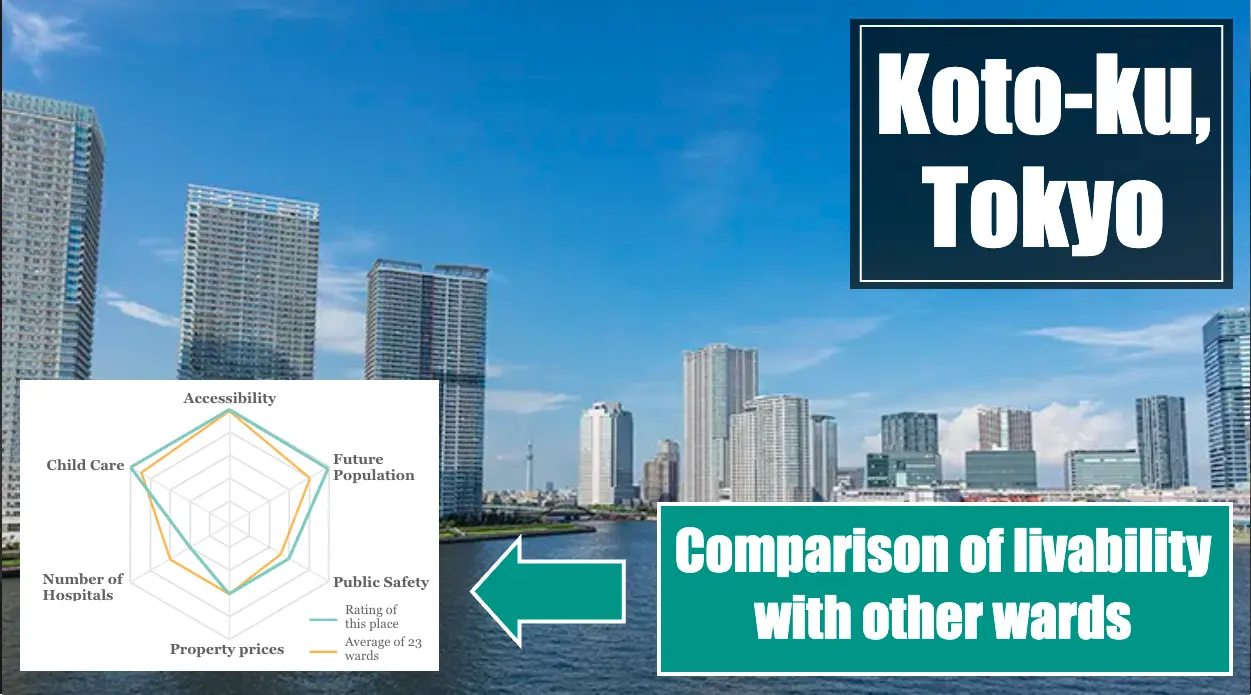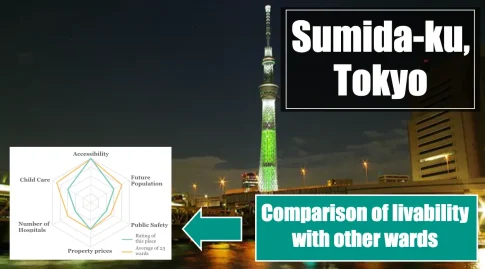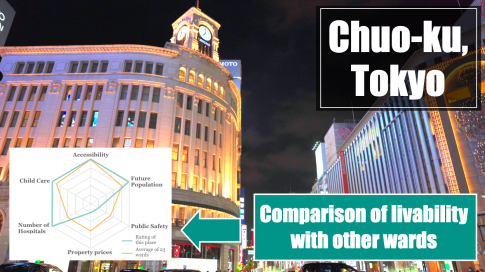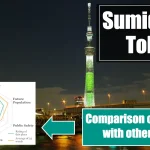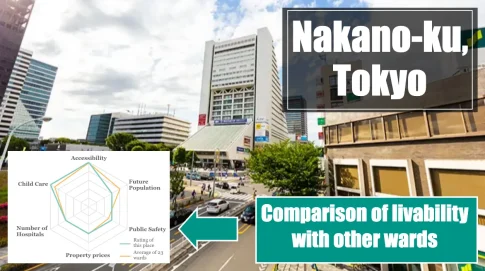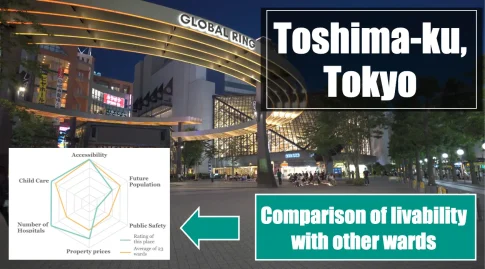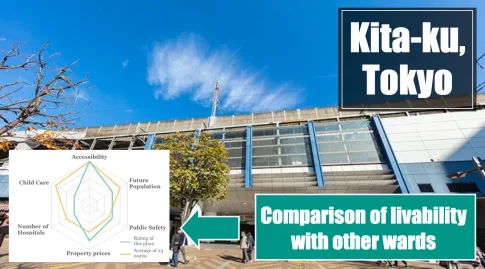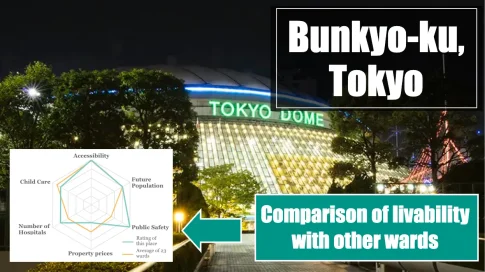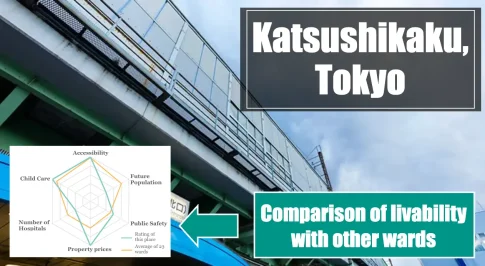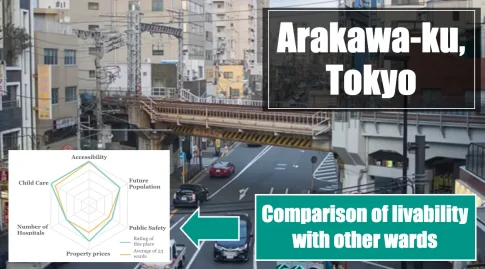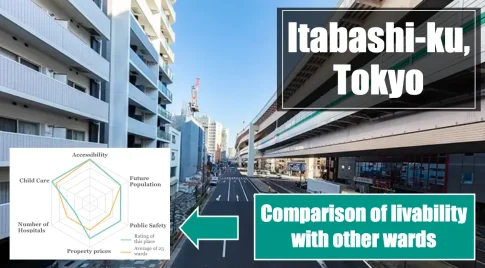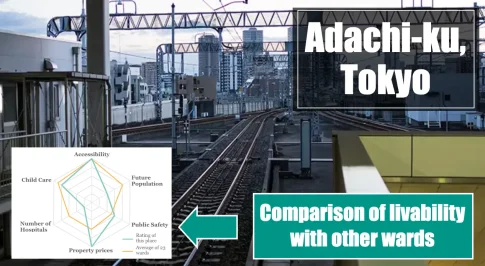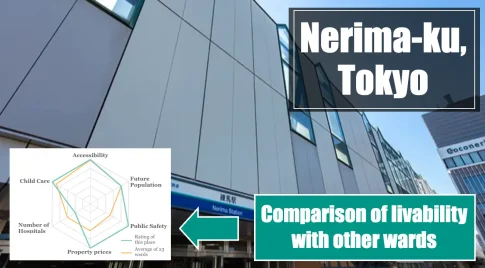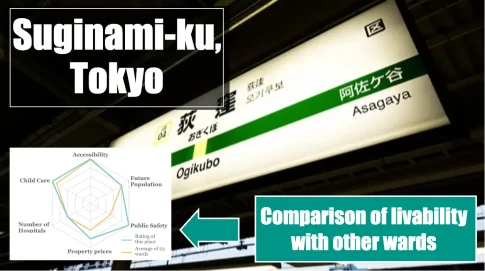This section introduces the livability of Koto ward, Tokyo compared to the other 23 wards.
Contents
Livability of Koto ward|First Conclusion
- Future population growth
- Area with few hospitals outside of 23 wards.
Koto-ku was home to many samurai residences, temples and shrines, and rice and oil wholesalers during the Edo period (1603-1867), and was the scene of the flourishing culture of the Edo common people. Today, the area is home to large-scale facilities such as Toyosu Market and Tokyo Big Sight, as well as cultural and leisure facilities such as the National Museum of Emerging Science and Innovation and KidZania Tokyo.

To give you a brief idea of the livability of such Koto-ku, the population is growing and the area is free of waiting children. On the other hand, there are fewer medical facilities per population compared to other wards.
Compare Koto-ku with other wards
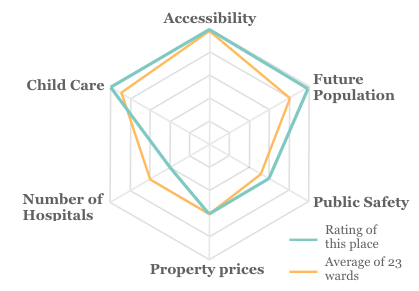
▼Accessibility
Calculated by the time it takes to get out to the Yamanote Line station.
5 = within 15 minutes
4 = within 20 minutes
3 = within 25 minutes
2 = within 30 minutes
1=more than 30 minutes
▼ Future Population
Calculated as percent change in population in 2045 relative to current population.
Over 110% = 5
Over 100% = 4
Over 90% = 3
Over 80% = 2
Less than 80% = 1
▼ Public Safety
The number of perceived crimes per 1,000 population is evaluated using the following criteria
5= less than 4 crimes per 1,000 people
4= less than 5
3= less than 6
2= less than 8
1= more than 8
▼ Property prices
Compared to the respective averages for rentals and condominiums in the 23 wards of Tokyo
5=30% or more reasonable price
4=10% or more but less than 30% of the price of the property
3=Less than 10% of the price before or after
2 = 10% or more but less than 30% more expensive price
1 = 30% or more expensive price
and then summed and re-evaluated.
▼ Number of medical facilities
(The number of medical facilities is evaluated against the average of Tokyo’s 23 wards (excluding extremely expensive wards) using the following criteria.
5=30% or more
4=10% or more but less than 30
3=10% or more, but less than 10%.
2=10% or more but less than 30
1=30% or more
▼ Child Care
The following criteria are used to evaluate against the number of children on waiting lists.
5 = 0 children on waiting list
4=Less than 5 children on the waiting list
3=Less than 10 children on the waiting list
2=Less than 50 children on the waiting list
1 = 50 or more children on the waiting list
Above, the green line is the valuation of Koto-ku, and the orange line is the average valuation of the other 23 wards of Tokyo. Let us look at each of them in turn.
Accessibility of Koto-ku
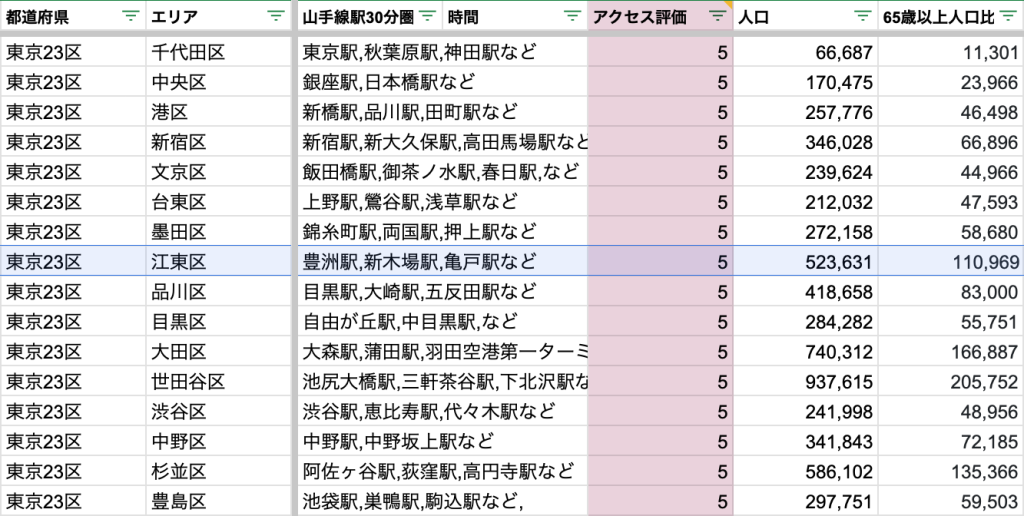
- JR Sobu Line: “Kameido” station
- JR Keiyo Line: “Etchujima Station”, “Shiomi Station”, “Shinkiba Station
- Yurikamome Line: Tokyo International Cruise Terminal Station, Telecom Center Station, Aomi Station, Tokyo Big Sight Station, Ariake Station, Ariake Tennis no Mori Station, Ichiba-mae Station, Shin Toyosu Station, Toyosu Station
- Tokyo Metro Tozai Line: “Monzennakacho Station,” “Kiba Station,” “Toyocho Station,” “Minamisunacho Station,” “Nishikasai Station,” “Kasai Station
- Tokyo Metro Yurakucho Line: “Toyosu”, “Tatsumi”, “Shinkiba
- Tokyo Metro Hanzomon Line: “Kiyosumi-Shirakawa” “Sumiyoshi” station
- Toei Shinjuku Line: Morishita Station, Sumiyoshi Station, Nishi-Oshima Station, Oshima Station, Higashi-Oshima Station
- Toei Oedo Line: Morishita Station, Kiyosumishirakawa Station, Monzennakacho Station
- Tokyo Waterfront Area Rapid Transit Rinkai Line: Shinkiba Station, Shinonome Station, Kokusai Tenjijo Station, Tokyo Teleport Station
- Tobu Kameido Line: Kameido Suijin Station, Kameido Station
Koto-ku has 10 lines and 28 stations.

It seems to be very convenient as it can go to Shibuya Station on the Tokyo Metro Hanzomon Line, Shinjuku Station on the Toei Oedo Line, and Ginza and Ikebukuro on the Tokyo Metro Yurakucho Line without transfers.
Koto-ku Population and Future Population
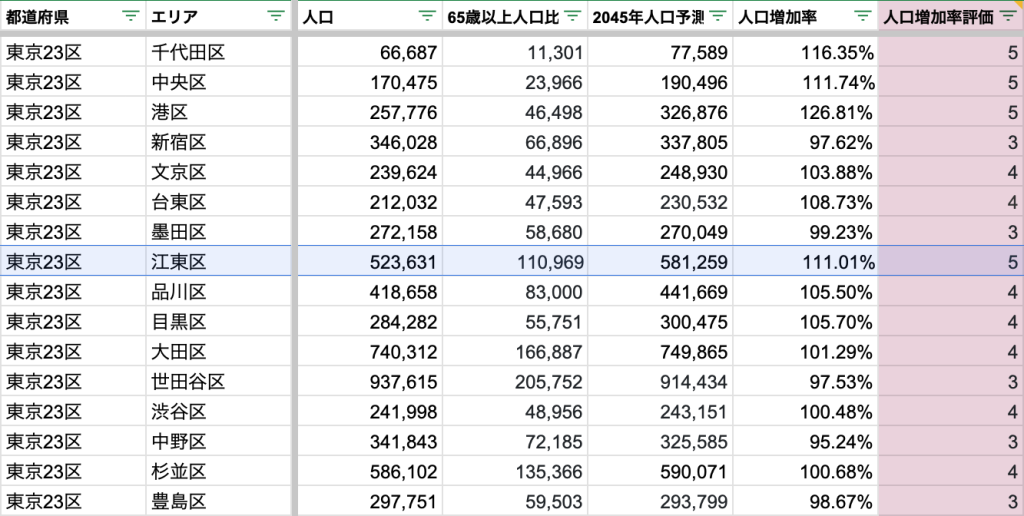
The population of Koto-ku is approximately 524,000.
The future population in 2045 will be 581,259 (111.01% increase), about 57,600 more than the current population. While the population is projected to decrease throughout Japan, a population increase of 11.01% is an excellent figure.

Even within the same 23 wards, there are areas where population is projected to decrease. In contrast, the fact that the population is projected to increase means that the value of the city, for example, in terms of real estate prices, will grow even more.
Is Koto city safe?
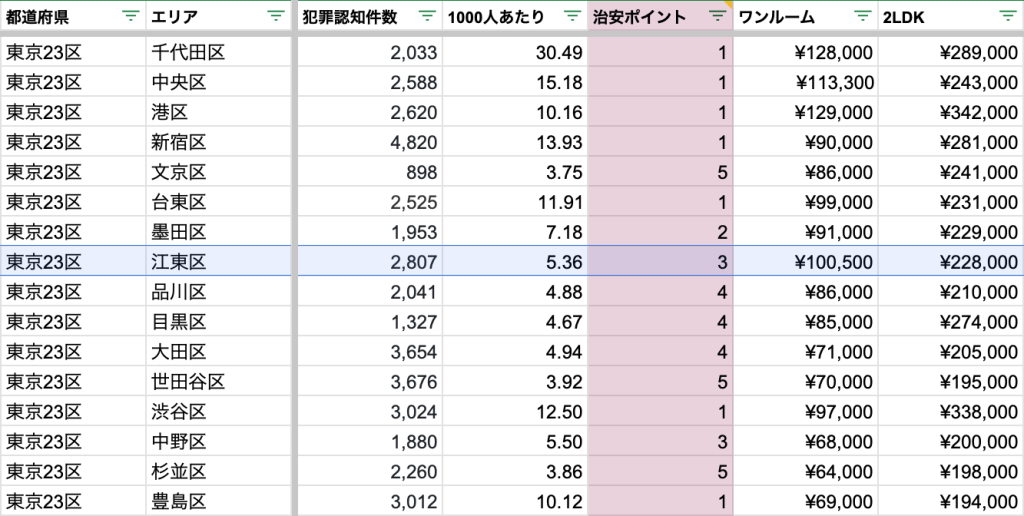
Compared to the surrounding wards, Koto-ku seems to be “average” in terms of public safety.
The number of crimes in 2022 was 2,807, which is 5.36 crimes per 1,000 people in Koto-ku.
Since the average number of crimes per 1,000 people in other wards is about 6 to 7, Koto-ku is rated as “average” in terms of public safety.

The number of crimes recognized has been decreasing since 2014, but bicycle thefts and violent crimes have been increasing in recent years.
Property quotes in Koto Ward
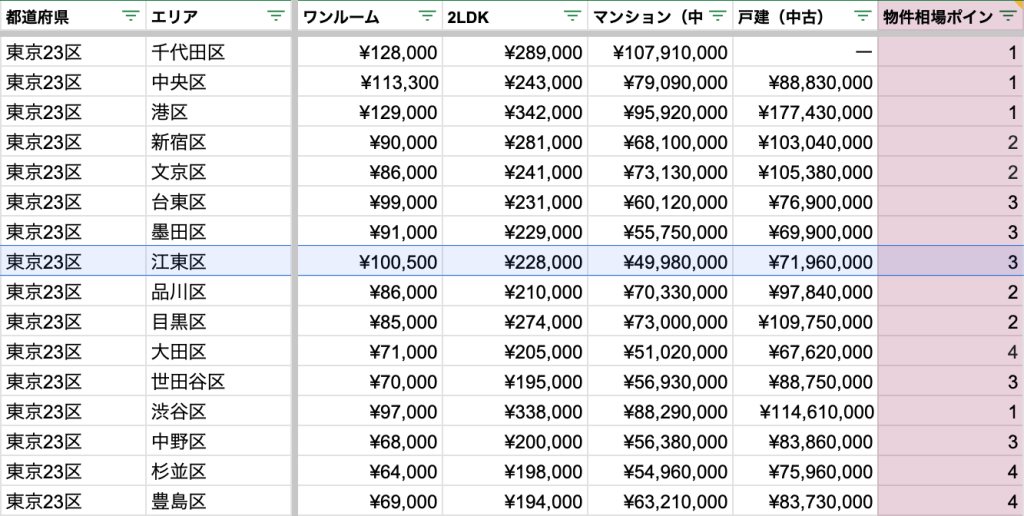
- One room rental = approx. 100,500 yen
- 2LDK rental = approx. 230,000 yen
- Condominium for sale = approx. 50,000,000 yen
- Detached house = approx. 72 million yen
The market prices of properties for rent and for sale in Koto-ku are shown above.

Compared to other surrounding wards as shown in the table, the property market in Koto-ku was rated average.
Number of Hospitals in Koto-ku
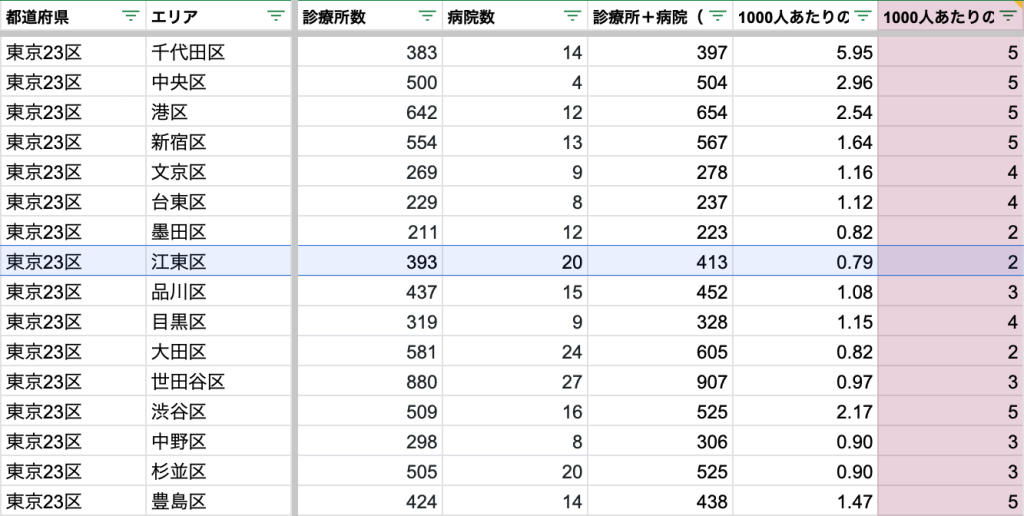
There are 413 hospitals and other medical facilities in Koto-ku.
This is 0.79 per 1,000 people, which is “below average” compared to the other 23 wards of Tokyo.
Koto-ku Childcare

As for childcare, according to 2022 data, there were 0 children on the waiting list in Koto-ku. In addition, there appear to be 109 pediatricians and 180 licensed childcare facilities.

There are wards within the 23 wards that have waiting lists for children. In contrast, Koto-ku has 0 children, which is a great point for families who want to leave their children with their parents.
“待機児童=Taiki jidō” in Japan refers to children who need but can’t secure a spot in childcare facilities due to shortage. This is a major social issue.
What you need to know before moving to Koto-ku

Here we report on the contents of the regional hazard measurement survey for earthquakes published by the Tokyo Metropolitan Government Bureau of Development.
The above figure is a color-coded chart of five levels of “overall risk” calculated from two factors, “building collapse risk” and “fire risk.
According to the chart, Koto Ward has the lowest risk level from rank 1 (light blue area) to rank 5 (brown area).
The areas in Koto Ward that are particularly dangerous (Rank 5) are as follows.
- 7 Oshima, Koto-ku, Tokyo
- 5 Kameido, Koto-ku, Tokyo
- 3, 4, 6 Kitasuna, Koto-ku, Tokyo
- 5 Higashisuna, Koto-ku, Tokyo
For more information, please visit the Koto-ku page of the Tokyo Metropolitan Government Bureau of Development. If you are considering moving to Koto-ku, we recommend that you take a look at this page.
Koto-ku livability summary
- Future population is projected to increase 【Good!】
- Public safety is average.
- Property prices are average.
- The number of hospitals is below average【Bad!】
- The number of children on waiting lists is 0【Good!】
We checked the livability of Koto-ku and found the above.
It is a good point that the future population is increasing and the number of children on waiting lists is zero. On the other hand, it should be noted that the number of hospitals is below average.

Why don’t you positively consider moving to Koto-ku?
▼Population
https://www.metro.tokyo.lg.jp/tosei/tokyoto/profile/gaiyo/kushichoson.html
▼Future population
https://jmap.jp/cities/detail/city/13101
▼Public order
https://www.keishicho.metro.tokyo.lg.jp/about_mpd/jokyo_tokei/jokyo/ninchikensu.files/R4.csv
▼Market price of property
https://suumo.jp/chintai/soba/tokyo/sc_chiyoda/
https://www.homes.co.jp/mansion/chuko/tokyo/chiyoda-city/price/
https://www.homes.co.jp/kodate/shinchiku/tokyo/23ku/city/price/
▼Taiki jido
https://www.city.chiyoda.lg.jp/koho/kosodate/hoikuen/shien/torikumi.html
▼Number of Hospitals
https://jmap.jp/cities/detail/city/13101
▼Number of approved childcare facilities
https://www.fukushi.metro.tokyo.lg.jp/kiban/fukushi_shisetsu/shs_list/202305.html
▼Tokyo Earthquake Hazard Level
https://www.toshiseibi.metro.tokyo.lg.jp/bosai/chousa_6/1chiyoda.htm
▼Population
https://www.metro.tokyo.lg.jp/tosei/tokyoto/profile/gaiyo/kushichoson.html
▼Future population
https://jmap.jp/cities/detail/city/13108
▼Public order
https://www.keishicho.metro.tokyo.lg.jp/about_mpd/jokyo_tokei/jokyo/ninchikensu.files/R4.csv
▼Market price of property
https://www.chintai.net/tokyo/area/13100/rent/1r/
https://www.homes.co.jp/mansion/chuko/tokyo/koto-city/list/
https://www.homes.co.jp/kodate/chuko/tokyo/23ku/city/price/
▼Taiki jido
https://www.hokatsunomikata.com/taiki_infos/635
▼Number of Hospitals
https://jmap.jp/cities/detail/city/13108
▼Number of approved childcare facilities
https://www.fukushi.metro.tokyo.lg.jp/kiban/fukushi_shisetsu/shs_list/202305.html
▼Tokyo Earthquake Hazard Level
https://www.toshiseibi.metro.tokyo.lg.jp/bosai/chousa_6/8koutou.htm
The information published on this site is the data at the time of the survey. Therefore, please be sure to check the latest data by yourself.
▼Other cities
Sumida ward, Tokyo. Survey of livability in Japan
Survey on livability of Chuo-ku, Tokyo. Moving to Japan.
▼Japanese article
江東区は治安悪い?やばい?住みたくない?他の東京23区と魅力や特徴比較
